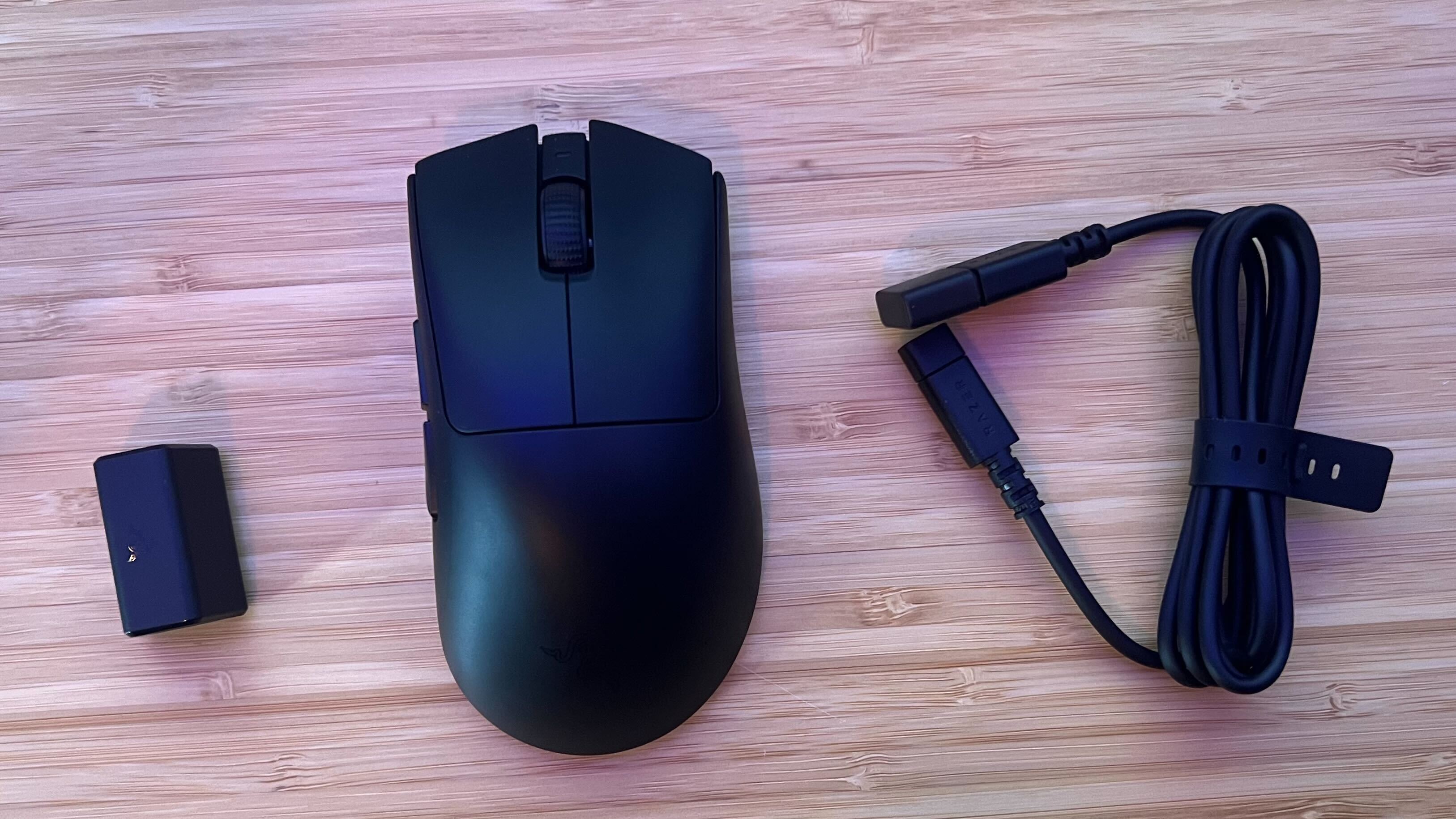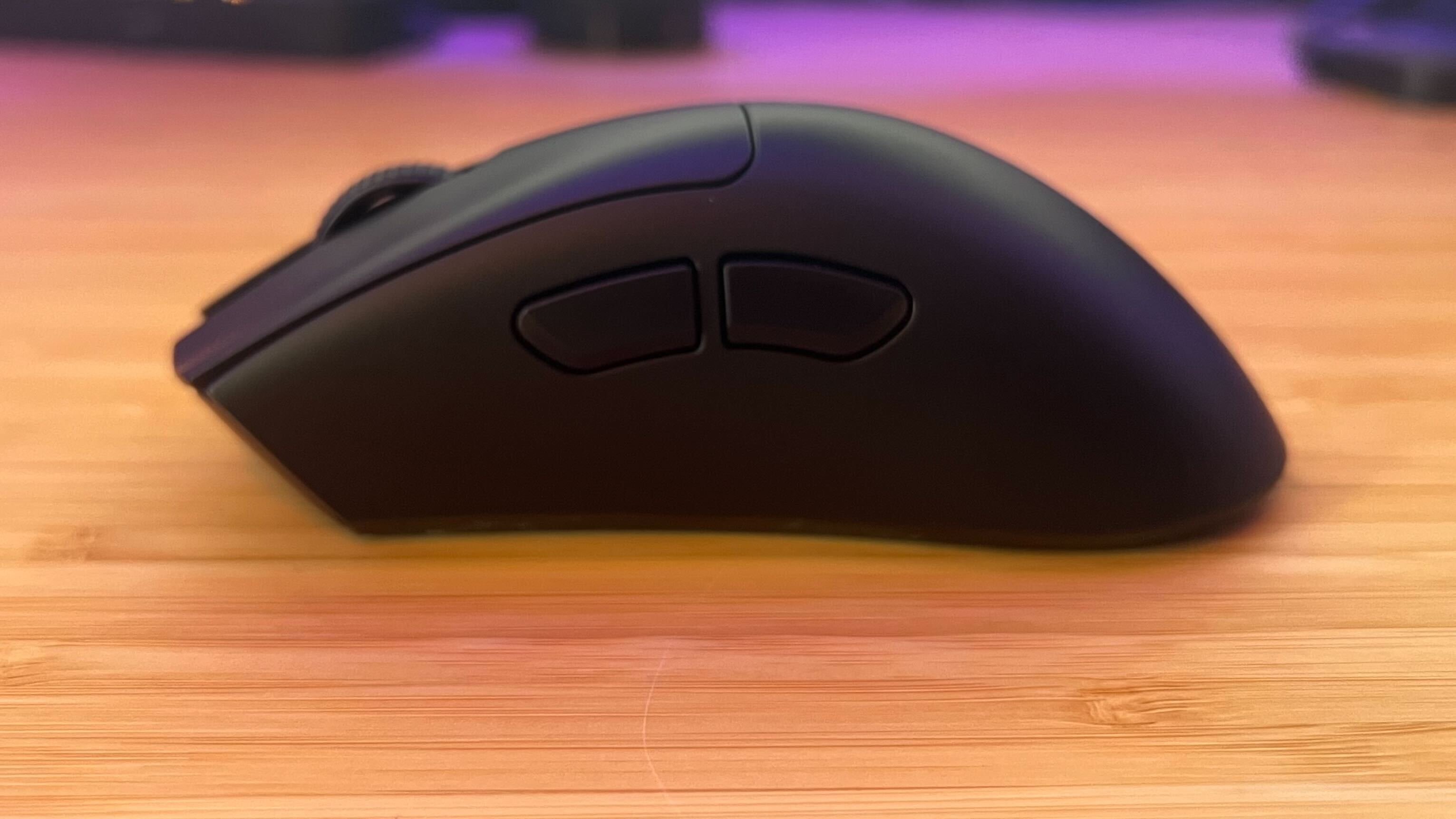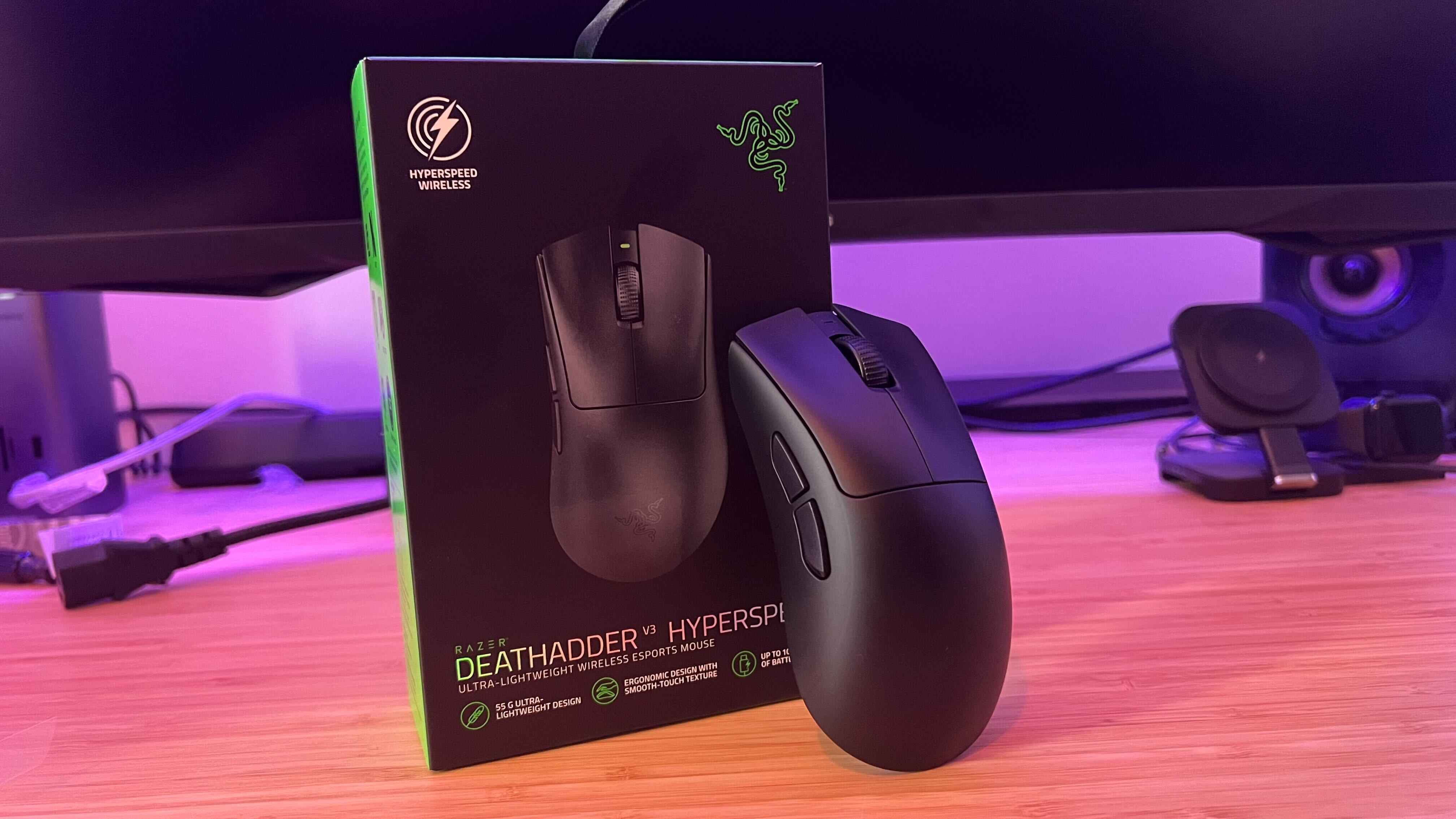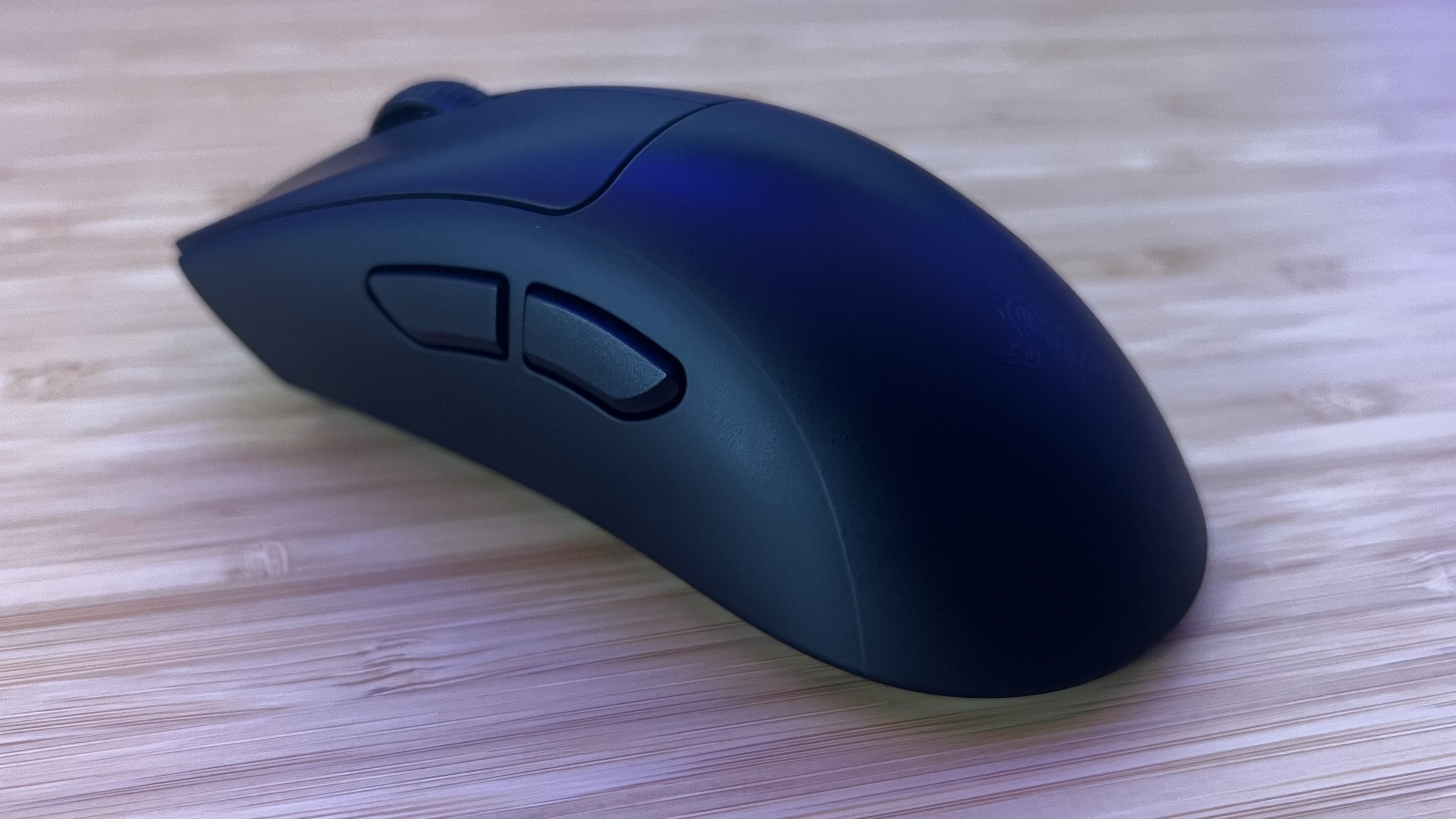GamesRadar+ Verdict
The Razer DeathAdder V3 Hyperspeed is a master class in value, offering everyday players the hardware to up their game without charging them for extra features they won’t need. Doing all that while remaining comfortable, sturdy, and packing its own unique benefits makes it one of the most impressive gaming mice I’ve tested so far.
Pros
- +
Fantastic performance
- +
No unnecessary feature bloat
- +
Impressive battery life
- +
Lightweight smaller form factor
- +
Grippy surface
Cons
- -
Plastic chassis can feel clammy
- -
Main clicks might be too heavy for some
Why you can trust GamesRadar+
I’ve always naturally preferred Razer’s Viper series over the DeathAdder. It might be the fact that the Viper Ultimate was my first entry to the brand, or it might be the traditionally flat shape that has, until this year, become a staple on the shelves. The new Razer DeathAdder V3 Hyperspeed might just change all that, though.
It’s the epitome of less is more, dropping ultra-competitive features away from the sensor profile in favor of the battery life, price tag, and weight that will actually appeal to everyday players. At $99.99 / £99.99, it’s consideringly cheaper than the current flagships, the $159.99 / $149.99 (£159.99 / £149.99) Viper V3 Pro and DeathAdder V3 Pro, and still manages to perform just as well - sometimes, even better. It’s competing with some of the best gaming mouse models on the market, and it’s got the value proposition to give them a real hard time.
Price | $99.99 / £99.99 |
Connection | 2.4GHz / Wired |
Shape | Right-handed |
Buttons | 6 |
DPI | 26,000 |
IPS | 500 |
Switches | Optical Mouse Switches Gen-3 |
Weight | 55g |
Battery | Up to 100 hours |
Design

Maybe it was the super flared design of the DeathAdder that always put me off in the past. I’m not a fan of the aesthetic or the feel, but the DeathAdder V3 Hyperspeed manages to retain the benefits to control with its slightly grooved main clicks without jutting out as far as something like the Razer DeathAdder V2 X. It’s still a little more pronounced than the Razer DeathAdder V3 Pro, but it never seemed to get in the way as much. The form factor retains the smooth shaping of more recent Razer gaming mouse options, with a relatively high dome and a nicely snug back region to nestle comfortably into the palm.
It’s a little smaller than previous releases, coming in roughly 5mm shorter than the V3 Pro, with a slight height reduction to match. While that might mean those with particularly large hands could prefer the extra space, the vast majority of players will be grateful for the gains in flickability and easier manipulation overall.
The V3 Hyperspeed is smaller than previous models, but it’s also lighter - and considerably so. At 55g, there’s a serious drop in weight compared to the more expensive 63g V3 Pro - it’s only a gram heavier than the current FPS leader, the Razer Viper V3 Pro. Crucially, the V3 Hyperspeed knows exactly where to carry its weight, balancing everything well to keep things nippy on the battlefield.
I usually see gaming mice dropping parts of their shells to achieve weights like this, as is the case with the similarly priced Glorious Model D 2. However, the DeathAdder V3 Hyperspeed manages to squeeze the scales while still retaining a full chassis. The matte soft-touch plastic does still feel a little clammy, particularly during warmer conditions, though. I’ve been testing the V3 Hyperspeed during a hot spell, and have noticed a growing irritation as that heat is transferred and retained by the plastic shell. It’s still plenty grippy and never slipped, but if you do tend to clam up it’s worth checking out the more textured surface of the Razer Viper V2 Pro or Razer Cobra Pro.

That’s not to say the V3 Hyperspeed doesn’t feel great in the hands. I was impressed at the natural contouring here, with all the right indents in all the right places making for a particularly smooth operation overall. I was able to comfortably maneuver using just my thumb and pinky, keeping three fingers ready for action at all times.
Despite this being a cheaper option in Razer’s lineup, the mouse still stands strong in the build quality department as well. I can’t creak or flex any parts of the main body no matter how hard I try, and the feet underneath provide a slick glide across a range of different surfaces as well. I often find that scroll wheels don’t lie - strangely, the quality of a scroll can tell you a lot about the overall sturdiness of a gaming mouse. The DeathAdder V3 Hyperspeed’s wheel feels strong and sturdy, with a nice level of resistance behind it and incredibly obvious steps in between each position. That’s particularly handy for a more precise weapon swap or scope zoom.
Features
This is where the DeathAdder V3 Hyperspeed gets a little more interesting. It’s a cheaper alternative to the V3 Pro, so its sensor is a step down on paper, offering a 26K DPI, 500 IPS, and 40g acceleration. That’s compared to the Pro’s 30K DPI, 750 IPS, and 70g acceleration, specs typical to the top of the market price point it inhabits. The only problem is that most players don’t need top-of-the-market specs. Casual players will struggle to move past 6,000 DPI - it’s really only the esports professionals who are going to be using top-shelf mice to their full potential.
The same goes for built-in hyper-polling. The V3 Hyperspeed runs at a 1,000Hz polling rate straight out of the box, as is industry standard. The V3 Pro packages 8,000Hz polling rates and charges you accordingly. Again, only very fast players will even notice a difference between these two settings (other than a complete battery drain and CPU slowdown) - they’re really only there to show off. I’m yet to formally publish my 8KHz polling diss track (though I’ve made a start with my guide to gaming keyboard polling rates), but I’m not a fan of paying more for something I don’t need just because a product page has told me it’s new and better.

This example can be taken as a microcosm of everything the V3 Hyperspeed gets right. It polls at 1,000Hz straight out of the box, but you can pick up an extra 8,000Hz dongle if you wish. Some might view that as a negative - Razer wants you to pay more to fully unlock all the features of the device. I see it as meeting casual players where they are in both price and performance, but still making it known that they can scream to go faster if they really want to.
You’re not just paying less for lower performance, though. Razer has added actually useful features to its device instead of high-end esports buzzwords. The V3 Hyperspeed debuts the brand’s Focus X 26K Optical Sensor, which packs two new configuration features through Synapse 3. The first is a sensor orientation guide rope, allowing for a more accurate positioning response when holding the mouse at an angle or lifting off and returning slightly skewed.
Then we have ‘Dynamic Sensitivity’ - a feature that, once it made its way into my muscle memory, quickly became invaluable during my gameplay. Essentially, you create a sensitivity curve based on the speed at which you move the pointer - the mouse then ramps up your DPI when that speed is hit. It’s an automatic adjustment that speeds up your movements only when you need it to, making for faster snaps to that unexpected enemy and quick turns during combat. Of course, you’ll also find all the usual customization options in Synapse, from button re-mapping to lift-off distance control and profile switching.

The latest DeathAdder also packs a rechargeable battery that has both the Viper V3 Pro and DeathAdder V3 Pro beat (another benefit of using a lower power sensor). Razer quotes this charge at up to 100 hours - a figure that rang true in my testing. A full battery dump took about eleven days (seven hours per day of work, plus an average of three hours gaming in the evening, with around four hours of gameplay during weekend days), with the mouse holding out for a couple of hours before dying on the 12th day. It’s also worth noting that last time I reviewed one of these cheaper DeathAdder models it relied solely on an AA battery.
Performance
The Razer DeathAdder V3 Hyperspeed proves that bigger isn’t always better - in terms of actual shape and sensor qualities. I found the cheaper Hyperspeed to be far more comfortable and slightly more accurate in-game than previous, more expensive, iterations. The sensor packs a super-fast response, keeping up with more competitive endeavors in a way I wouldn’t have expected having tested plenty of $99.99 gaming mice in the past. It’s difficult for a gaming mouse to actually improve your accuracy and speed, but the light, well-balanced weight, snappy sensor, and low click latency meant achieving faster response times and more precise enemy tracking felt more natural during my testing. The mouse doesn’t make the player, but the V3 Hyperspeed certainly helps you become the player you want to be.

Even slower games felt better. The optical switches under each main click (the same Gen 3 Optical model you’ll find in most of Razer’s current portfolio) provide a super satisfying crunch, with a crisp feel and a clean but still tactile resistance. Some might prefer a softer switch, especially if you don’t want excessive noise in your setup (these are among the louder clackers I’ve tested), and I did find repeat presses were a little more labored than they are with something looser like the Cobra Pro.
The side buttons mirror this switch feel, albeit with a slightly higher-pitched sound profile. They’re also among my favorites I’ve tested so far. The actual buttons are much larger than those of the Cobra Pro or Viper series, but I never accidentally mis-clicked. They’re positioned a good height away from the natural resting position of the thumb, so don’t get underfoot too often, but still provide a super-fast response when needed.
Should you buy the Razer DeathAdder V3 Hyperspeed?

If you’re on the hunt for a wireless gaming mouse under $100 / £100, the Razer DeathAdder V3 Hyperspeed is the first model I’d point you towards. It’s the best value wireless model I’ve tested so far (the Razer Basilisk V3 is the best value overall, due to its sub-$50 price point in exchange for a wired connection), packing everything you need for an excellent gaming experience without charging you for unnecessary extras. It’s rare to find a gaming mouse that does all that while still feeling comfortable in-hand, offering a durable build quality, and being supported by a robust set of software features.
If you’re going all out on performance (and you know you’ll use the sensor to its full advantage), I’d move up the scale to the Razer Viper V3 Pro or Razer Viper V2 Pro. The former will net you a slightly lower 54g weight and a comparable 95-hour battery life, with the full 35K sensor and 8K hyperpolling out the box. However, the majority of competitive players who do want bigger specs should be settling down with the V2 Pro instead. It’s regularly on sale for close to $99.99 these days, and boosts your sensor to 30K / 750 IPS - albeit at a weight and battery sacrifice.
Specs | Razer DeathAdder V3 Hyperspeed | Razer DeathAdder V3 Pro | Razer Viper V3 Pro | Razer Viper V2 Pro |
|---|---|---|---|---|
Price | $99.99 / £99.99 | $149.99 / £149.99 | $159.99 / £159.99 | $149.99 ($99.99 on sale) / £149.99 |
Connection | 2.4GHz / Wired | 2.4GHz / Wired | 2.4GHz / Wired | 2.4GHz / Wired |
Shape | Right-handed | Right-handed | Right-handed | Right-handed |
Buttons | 6 | 6 | 6 | 6 |
DPI | 26,000 | 30,000 | 35,000 | 30,000 |
IPS | 500 | 750 | 750 | 750 |
Switches | Optical Mouse Switches Gen-3 | Optical Mouse Switches Gen-3 | Optical Mouse Switches Gen-3 | Optical Mouse Switches Gen-3 |
Weight | 55g | 63g | 54g | 58g |
Battery | Up to 100 hours | Up to 90 hours | Up to 95 hours | Up to 80 hours |
How I tested the Razer DeathAdder V3 Hyperspeed
I used the Razer DeathAdder V3 Hyperspeed as my daily driver for all work and play over the course of four weeks. I spent the first two weeks of testing using the device as I would any other, playing the games currently on my roster (Octopath Traveler, Fallout 4, and Assassin’s Creed: Odyssey). I then spent a further two weeks specifically testing across more competitive titles like Apex Legends and CS2 as well. These games were used to test sensor accuracy, acceleration, latencies, repeat presses, and lift-off precision more formally. However, I also made specific note of side-button performance and switch travel distance during slower games like Assassin’s Creed.
I fully charged the battery on receiving the mouse, and ran it until a complete flat over the course of the first week of testing, while also noting any performance issues at low battery levels at the same time.
For more information on how we test gaming mice, check out the full GamesRadar+ Hardware Policy.
We’re also rounding up all the best wireless gaming mouse options as well as the best mouse pads for gaming as well. If you’re after a completely different brand, check out the best Logitech gaming mice on the market right now.

Managing Editor of Hardware at GamesRadar+, I originally landed in hardware at our sister site TechRadar before moving over to GamesRadar. In between, I've written for Tom’s Guide, Wireframe, The Indie Game Website and That Video Game Blog, covering everything from the PS5 launch to the Apple Pencil. Now, i'm focused on Nintendo Switch, gaming laptops (and the keyboards, headsets and mice that come with them), PS5, and trying to find the perfect projector.




